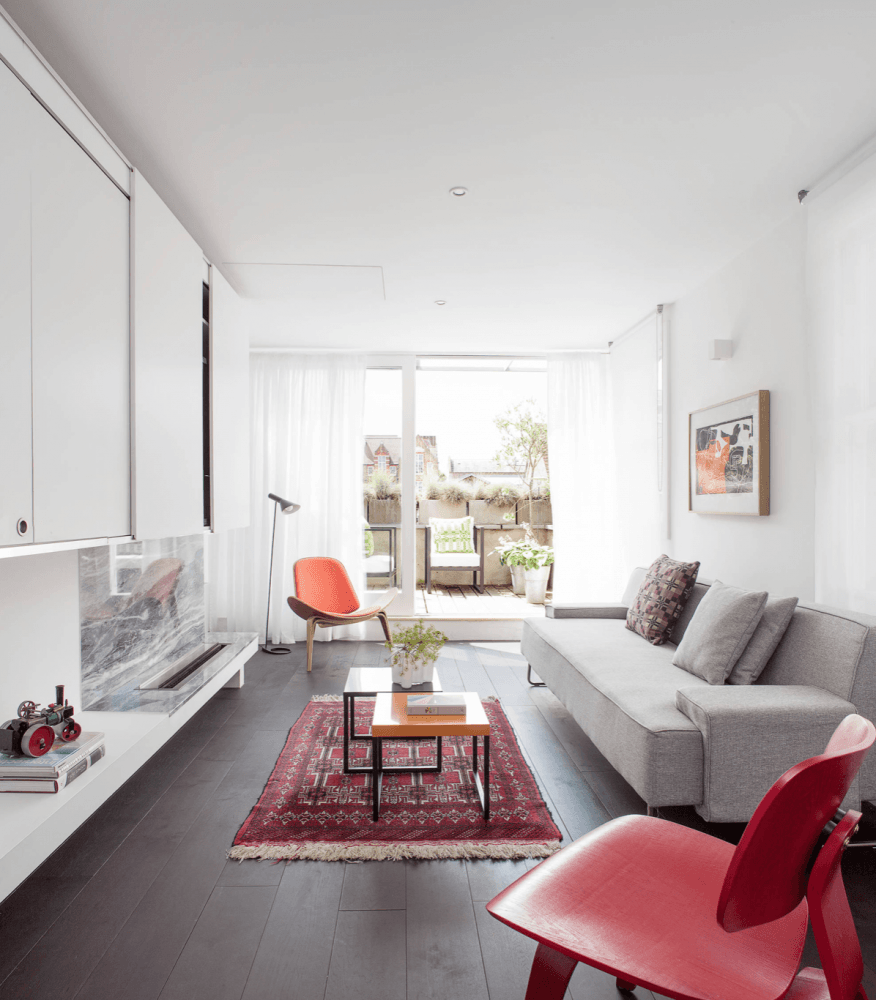It’s one thing clicking through images of gorgeous rooms when gathering inspiration for your own home, but sometimes doesn’t it seem like those ideas will only work in rooms that are on an epic scale? Or those that are pleasingly proportioned to start with? The truth is, when a room is well designed, we probably don’t notice that it’s an awkward shape – and that’s the key. And so, in a new series, three interior designers reveal some of their insider tips for dealing with awkward-shaped spaces. First off, how to make the most of a long, narrow room.
This post was originally posted by Houzz and you can find it by clicking here
Professional advice from:
Letiche Black of Amberth
Charlotte Ford of Cotton Tree Interiors
Diana Greenhalgh of My Bespoke Room

Let it flow
‘The challenge you face with a long, thin living space is to ensure the room feels welcoming, inviting and free-flowing,’ says Letiche Black at Amberth Interiors. ‘You want to avoid it looking too static or formal.’
She advises ensuring that the seating area doesn’t feel awkward or too far away from the TV and other necessities. ‘The biggest challenge,’ she continues, ‘will be not to feel obliged to push everything against the walls – because you will only emphasise the narrow shape and corners, and be left with a slim walkway. The space will feel tight and cramped instead of open and light.’
Diana Greenhalgh from My Bespoke Room also suggests, as seen in this room, using areas of colour. ‘These will draw the eye to certain points around the room to help break up the space,’ she explains.

Maximise space with style
Diana Greenhalgh suggests making a feature of details that will maximise the feeling of space in a narrow room. ‘Space-saving solutions such as small shelves instead of bedside tables, and hanging pendant lights instead of bulky bedside lights can help make the most of the available space, and also assist by creating an interesting focal point,’ she says.

Lead with light
In a long, thin living area, Letiche Black recommends designing the space around the main natural light source, positioning the seating as close to it as possible. ‘This will influence how you design the rest of the space and encourages a loose placement of other furniture,’ she explains. ‘Position armchairs away from the wall, as this tricks the eye into believing the space is much wider.’

Section it off
‘Break a long room into sections by cleverly placing furniture,’ says Charlotte Ford at Cotton Tree Interiors.
‘Console tables are really useful when placed at the back of a sofa,’ she says. ‘And if possible, get some floor-mounted sockets, so lamps can be put on them to bring in subtle lighting and create a soft divide.’
She also advises looking at the size of all your furniture when buying a new sofa, since most UK sofa manufacturers offer a service to change standard dimensions. ‘So you could have your sofa made narrower, in order to fit more seating into a space,’ she explains.

Take the textural route
Letiche Black suggests introducing plenty of texture to a thin room. ‘Create layers and warmth that will allow your senses to be met with an arrangement of smooth, rough and shiny surfaces, instead of lonely corners,’ she says. ‘Use mirrors, too, as these will help the space to feel wider.’
In a bedroom, Diana Greenhalgh advises considering the position of the bed with care, as it is likely to be the focal point of the room. Of course in many cases, there may be little choice about where it goes. Whether there is more than one option or not, Diana suggests that placing a bed at the end of a narrow space, as seen here, creates an immediate statement as soon as you walk in. Follow the stylish example in this room and play up to the room’s shape.

Distract the eye
‘Use neutral window treatments, as drawing attention to the boundaries at either end of the room only emphasises its shape,’ explains Charlotte Ford. ‘Use pattern, texture and colour on occasional chairs, cushions, lampshades and art, and also carefully positioned wallpaper, all of which take the focus off the shape of the room and directs it on to the more interesting objects.’

Don’t be afraid of the dark
‘If the room is dark, due to lack of windows,’ says Diana Greenhalgh, referring to a common issue in rooms with limited external wallspace, ‘go with it and embrace a dark colour palette to make the space cosy, rather than trying to fight it.’

Find your focus
One of the difficulties in decorating a narrow room is deciding where the focus of the space should be, says Charlotte Ford.
If you are thinking of employing a builder, work with them to create subtle room divides .’Full-length narrow columns break up the room, giving a natural finishing point when using different wallpapers and paint colours,’ she says.

Cut out the ‘corridor effect’
‘Choose items that can be positioned to break up the feeling of a long, thin room, such as small coffee tables, side tables or armchairs,’ says Diana Greenhalgh.
‘Break up the “corridor effect” by positioning pieces of furniture in clusters, instead of in a row,’ she says. This tricks the eye into seeing a wider space. ‘For example, pick different seating options and arrange them together, instead of having just one long sofa against the long wall.’
And don’t be afraid to use bold furnishings, fixtures and fittings, adds Letiche Black, ‘It will add visual interest to the space.’

